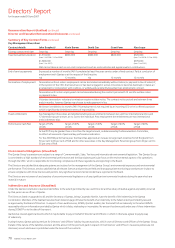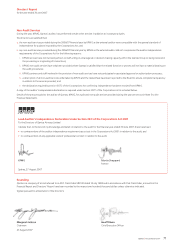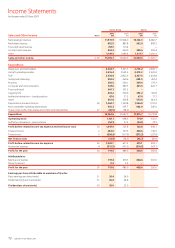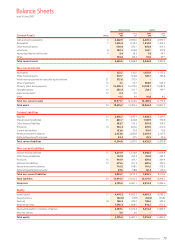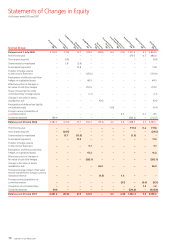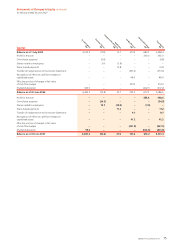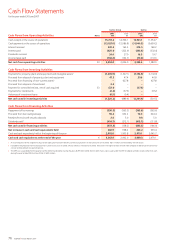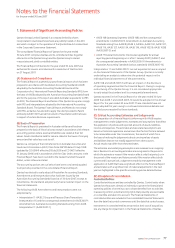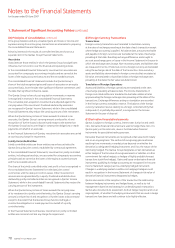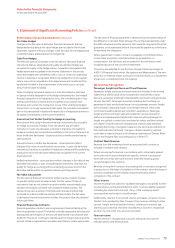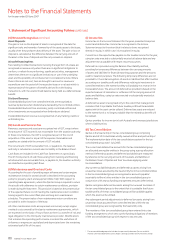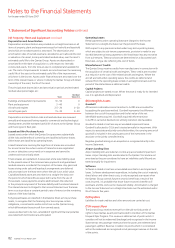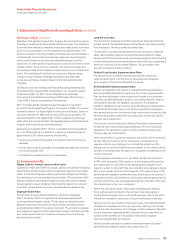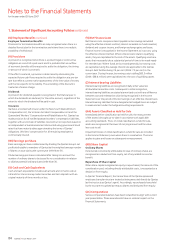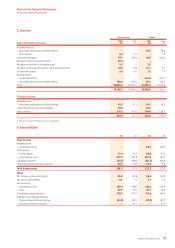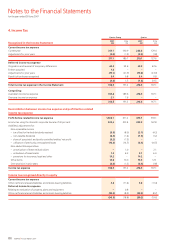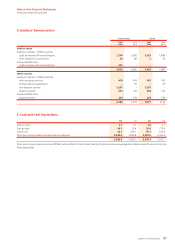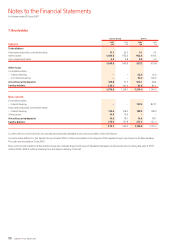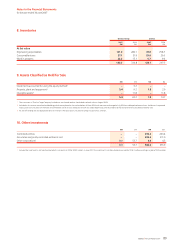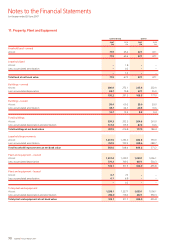Qantas 2007 Annual Report Download - page 82
Download and view the complete annual report
Please find page 82 of the 2007 Qantas annual report below. You can navigate through the pages in the report by either clicking on the pages listed below, or by using the keyword search tool below to find specific information within the annual report.80 Qantas |Annual Report 2007
(G) Revenue Recognition continued
Asset Disposals
The gain or loss on the disposal of assets is recognised at the date the
significant risks and rewards of ownership of the asset passes to the buyer,
usually when the purchaser takes delivery of the asset. The gain or loss on
disposal is calculated as the difference between the carrying amount of
the asset at the time of disposal and the net proceeds on disposal.
Aircraft Financing Fees
Fees relating to linked transactions involving the legal form of a lease are
recognised as revenue only when there are no significant obligations to
perform, or refrain from performing, significant activities, management
determines there are no significant limitations on use of the underlying
asset and the possibility of reimbursement is considered remote. Where
these criteria are not met, fees are brought to account as revenue or
expenditure over the period of the respective lease or on a basis which is
representative of the pattern of benefits derived from the leasing
transactions, with the unamoritised balance being held as a deferred lease
benefit.
Dividend Revenue
Dividends/distributions from controlled entities are recognised as
revenue by Qantas when dividends are declared by the controlled entities.
Dividends/distributions from associates, jointly controlled entities and
other investments are recognised when dividends are declared.
Dividend/distribution revenue is recognised net of any franking credits or
withholding tax.
(H) Goods and Services Tax
Revenues, expenses and assets are recognised net of GST, except where
the amount of GST incurred is not recoverable from the taxation authority.
In these circumstances, the GST is recognised as part of the cost of
acquisition of the asset or as part of the expense. Receivables and
payables are stated with the amount of GST included.
The net amount of GST recoverable from, or payable to, the taxation
authority is included as a current asset or liability in the Balance Sheet.
Cash flows are included in the Cash Flow Statement on a gross basis.
The GST components of cash flows arising from investing and financing
activities which are recoverable from, or payable to, the taxation authority
are classified as operating cash flows.
(I) Maintenance and Overhaul Costs
Accounting for the cost of providing major airframe and certain engine
maintenance checks for owned aircraft is described in the accounting
policy for property, plant and equipment (Note 1(Q)). With respect to
operating lease agreements, where the Qantas Group is required to return
the aircraft with adherence to certain maintenance conditions, provision
is made during the lease term. This provision is based on the present value
of the expected future cost of meeting the maintenance return condition
having regard to the current fleet plan and long-term maintenance
schedules. The present value of non-maintenance return conditions are
provided for at the inception of the lease.
All other maintenance costs are expensed as incurred, except engine
overhaul costs covered by third party maintenance agreements, which
are expensed on the basis of hours flown as there is a transfer of risk and
legal obligation to the third party maintenance provider. Modifications
that enhance the operating performance or extend the useful lives of
airframes or engines are capitalised and depreciated over the remaining
estimated useful life of the asset.
(J) Income Tax
Income tax on the Income Statement for the years presented comprises
current and deferred tax. Income tax is recognised in the Income
Statement except to the extent that it relates to items recognised
directly in equity, in which case it is recognised in equity.
Current tax is the expected tax payable on the taxable income for the year,
using tax rates enacted or substantially enacted at balance date and any
adjustment to tax payable with respect to previous years.
Deferred tax is provided using the Balance Sheet liability method,
providing for temporary differences between the carrying amounts
of assets and liabilities for financial reporting purposes and the amounts
used for taxation purposes. The following temporary differences are not
provided for: the initial recognition of assets or liabilities that affect neither
accounting nor taxable profit and differences relating to investments in
controlled entities to the extent that they will probably not reverse in the
foreseeable future. The amount of deferred tax provided is based on the
expected manner of realisation or settlement of the carrying amount of
assets and liabilities, using tax rates enacted or substantially enacted at
balance date.
A deferred tax asset is recognised only to the extent that management
considers that it is probable that future taxable profits will be available
against which the asset can be utilised. Deferred tax assets are reduced
to the extent that it is no longer probable that the related tax benefit will
be realised.
Qantas provides for income tax in both Australia and overseas jurisdictions
where a liability exists.
(K) Tax Consolidation
Qantas is the head entity in the tax consolidated group comprising
Qantas and all of its Australian wholly-owned entities and partnerships.1
The implementation date of the tax consolidations system for the tax
consolidated group was 1 July 2003.
The current and deferred tax amounts for the tax consolidated group
are allocated among the entities in the group using a group allocation
method. Deferred tax assets and deferred tax liabilities are measured
by reference to the carrying amounts of the assets and liabilities in
the Balance Sheet of Qantas and their tax values applying under
tax consolidation.
Any current tax liabilities/assets and deferred tax assets arising from
unused tax losses assumed by the head entity from the controlled entities
in the tax consolidated group are recognised as amounts payable/
(receivable) to/(from) other entities in the tax consolidated group in
conjunction with any tax funding arrangement amounts (refer below).
Qantas recognises deferred tax assets arising from unused tax losses of
the tax consolidated group to the extent that it is probable that future
taxable profits of the tax consolidated group will be available against
which the asset can be utilised.
Any subsequent period adjustments to deferred tax assets arising from
unused tax losses assumed from controlled entities within the tax
consolidated group are recognised by the head entity only.
The members of the tax consolidated group have entered into a tax
funding arrangement, which sets out the funding obligations of members
of the tax consolidated group with respect to tax amounts.
The tax consolidated group also includes the partnership between Qantas and AAL
Aviation Limited and between Qantas Flight Catering Limited and AAL Aviation Limited.
1
Notes to the Financial Statements
for the year ended 30 June 2007
1. Statement of Significant Accounting Policies continued


